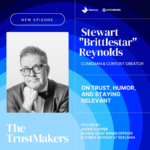By Phil Acton, UK Country Manager at Adform
Google’s long-promised cookie phase-out has been shelved — a frustrating anticlimax for an industry that’s been waiting and preparing for years. Those who banked on the Privacy Sandbox are now scrambling as it likely goes back to the drawing board; for everyone else, this isn’t a green light to revert to old habits.
The writing has been on the wall for a long time. The value of third-party identifiers (IDs) continues to erode rapidly. Regulatory pressure is mounting, consumer privacy preferences are shifting, and most digital environments have already moved on from cookie-based targeting. Here in the UK, around 40% of bid requests are already cookieless. Meanwhile, advertising’s fastest-growing mediums like retail media, connected TV, and DOOH have never relied on it.
Google’s U-turn doesn’t reverse any of this. In fact, the only thing that has changed is that Google has proven it has not managed to fulfill its promises.
For advertisers thinking about what to do next – the answer is clear. The future is not based on cookies, but multiple IDs.
Changing the identity game
If there is one good outcome of Google’s toing and froing on cookies, it is that the broader industry used this time to test and definitely prove that programmatic does not need Google to be effective.
Aside from the third-party cookie, there are over 400 IDs in play today, ranging from universal IDs based on deterministic, hybrid, and probabilistic methodologies to proprietary, publisher-owned IDs. Each one has unique attributes and offers value to different parts of the open web.
What this means for advertisers is that relying on only one or two IDs no longer provides the reach and scale needed, especially with the increasing variety of publishers using different identifiers. If advertisers want to be able to reach 100% of people online, they require robust and flexible solutions that can simplify and automate audience targeting across these multiple environments. For example, using first-party IDs for targeting on Chrome where third-party cookies are still present, default to a third-party cookie if needed, or switch to using a basket of first-party IDs.
Getting multi-ID ready
For those who have not yet started on their multi-ID journey, they should begin by laying out a roadmap for testing a variety of solutions and seeing which ones work for the business. Different combinations of first-party data, unified ID, and collaborative data sharing solutions should be explored to maximise effectiveness, reach, and scale.
Among these strategies, first-party IDs will be the driving force. Being fully controlled by the publisher or the advertiser, and able to be used across browsers and devices, reach, frequency, and audience targeting can all be optimised to achieve the best possible results for advertisers based on a better understanding of users. Ultimately, this means more efficient campaigns that produce less media wastage, greater reach and work toward brand-specific objectives.
Impact of AI
Alongside the cookieless age, we are also in the AI Age, and technology can be thanked for delivering this enhanced degree of efficient media planning. Solutions are now available that can fine-tune audience reach, recommend which channels and media to invest in, and forecast success in near real-time.
As cookieless channels like CTV, audio, and DOOH continue to gain traction, these automated tools will be at their core and will propel omnichannel performance well beyond the cookie’s historic capabilities. Advertisers should ensure that their tech stack investments are sufficiently directed at this technology.
Be identity proactive
Google may have completely pulled the plug on its plans to deprecate third-party cookies, but the industry shouldn’t be bowing down and once again surrendering all control to the tech giant. It’s time for advertisers to change the game and look beyond the status quo.
There are a number of alternative solutions available to explore, and the right combination will elevate the performance of campaigns to new heights. In particular, advertisers should be looking out for AI-led technology for precise targeting and reliable measurement provided through a variety of first-party IDs. This will deliver the outcomes that advertisers need while driving the best efficiency from their budgets.
It’s time to step out of Google’s shadow, be proactive and start delivering truly game-changing omnichannel advertising.











